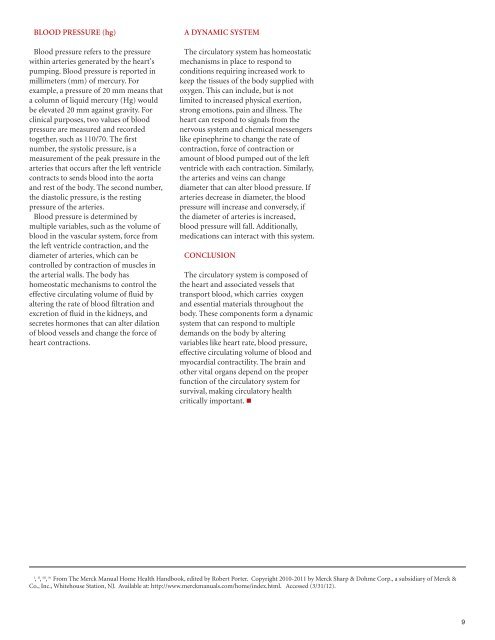Heart disease in tHe fire service - West Valley City Firefighters, IAFF ...
Heart disease in tHe fire service - West Valley City Firefighters, IAFF ...
Heart disease in tHe fire service - West Valley City Firefighters, IAFF ...
Create successful ePaper yourself
Turn your PDF publications into a flip-book with our unique Google optimized e-Paper software.
BLOOD PRESSURE (hg)<br />
Blood pressure refers to the pressure<br />
with<strong>in</strong> arteries generated by the heart’s<br />
pump<strong>in</strong>g. Blood pressure is reported <strong>in</strong><br />
millimeters (mm) of mercury. For<br />
example, a pressure of 20 mm means that<br />
a column of liquid mercury (Hg) would<br />
be elevated 20 mm aga<strong>in</strong>st gravity. For<br />
cl<strong>in</strong>ical purposes, two values of blood<br />
pressure are measured and recorded<br />
together, such as 110/70. The first<br />
number, the systolic pressure, is a<br />
measurement of the peak pressure <strong>in</strong> the<br />
arteries that occurs after the left ventricle<br />
contracts to sends blood <strong>in</strong>to the aorta<br />
and rest of the body. The second number,<br />
the diastolic pressure, is the rest<strong>in</strong>g<br />
pressure of the arteries.<br />
Blood pressure is determ<strong>in</strong>ed by<br />
multiple variables, such as the volume of<br />
blood <strong>in</strong> the vascular system, force from<br />
the left ventricle contraction, and the<br />
diameter of arteries, which can be<br />
controlled by contraction of muscles <strong>in</strong><br />
the arterial walls. The body has<br />
homeostatic mechanisms to control the<br />
effective circulat<strong>in</strong>g volume of fluid by<br />
alter<strong>in</strong>g the rate of blood filtration and<br />
excretion of fluid <strong>in</strong> the kidneys, and<br />
secretes hormones that can alter dilation<br />
of blood vessels and change the force of<br />
heart contractions.<br />
A DYNAMIC SYSTEM<br />
The circulatory system has homeostatic<br />
mechanisms <strong>in</strong> place to respond to<br />
conditions requir<strong>in</strong>g <strong>in</strong>creased work to<br />
keep the tissues of the body supplied with<br />
oxygen. This can <strong>in</strong>clude, but is not<br />
limited to <strong>in</strong>creased physical exertion,<br />
strong emotions, pa<strong>in</strong> and illness. The<br />
heart can respond to signals from the<br />
nervous system and chemical messengers<br />
like ep<strong>in</strong>ephr<strong>in</strong>e to change the rate of<br />
contraction, force of contraction or<br />
amount of blood pumped out of the left<br />
ventricle with each contraction. Similarly,<br />
the arteries and ve<strong>in</strong>s can change<br />
diameter that can alter blood pressure. If<br />
arteries decrease <strong>in</strong> diameter, the blood<br />
pressure will <strong>in</strong>crease and conversely, if<br />
the diameter of arteries is <strong>in</strong>creased,<br />
blood pressure will fall. Additionally,<br />
medications can <strong>in</strong>teract with this system.<br />
CONCLUSION<br />
The circulatory system is composed of<br />
the heart and associated vessels that<br />
transport blood, which carries oxygen<br />
and essential materials throughout the<br />
body. These components form a dynamic<br />
system that can respond to multiple<br />
demands on the body by alter<strong>in</strong>g<br />
variables like heart rate, blood pressure,<br />
effective circulat<strong>in</strong>g volume of blood and<br />
myocardial contractility. The bra<strong>in</strong> and<br />
other vital organs depend on the proper<br />
function of the circulatory system for<br />
survival, mak<strong>in</strong>g circulatory health<br />
critically important. n<br />
i<br />
, ii , iii , iv From The Merck Manual Home Health Handbook, edited by Robert Porter. Copyright 2010-2011 by Merck Sharp & Dohme Corp., a subsidiary of Merck &<br />
Co., Inc., Whitehouse Station, NJ. Available at: http://www.merckmanuals.com/home/<strong>in</strong>dex.html. Accessed (3/31/12).<br />
9

















